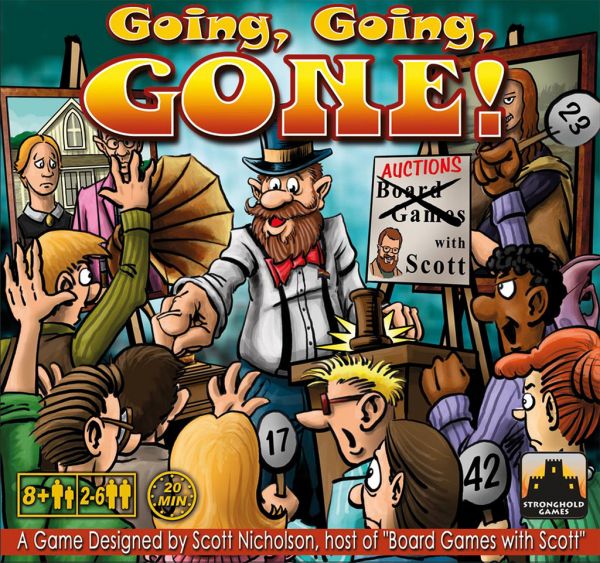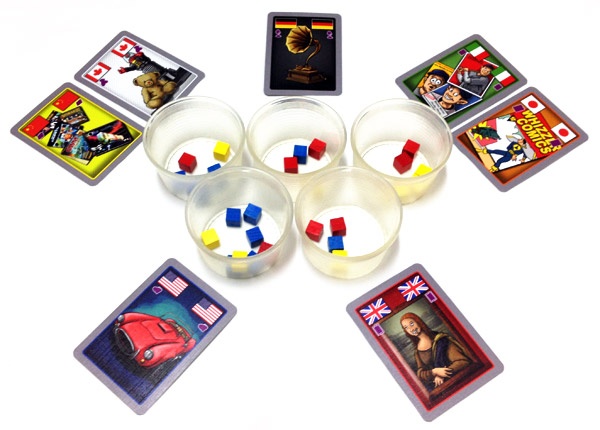Speed Auctions and Cups: A Review of Going, Going, GONE!

When I think of auctions, I think of a rambling auctioneer standing at the front of a room full of distinguished and snobby guests who calmly lift their signs to place a bid. You will not find that kind of auction in Going, Going, GONE!, a new game by Stronghold Games — instead, you'll find frantic (and possibly unkempt) players fumbling with cubes, yelling, and laughing loudly. Once you give it a try, you'll never think of auctions the same way ever again.
Gameplay
Going, Going, GONE! is a game for 2 to 6 players that consists of 5 clear plastic cups, a number of colored cubes for up to 6 players, and a deck of item cards. Each item card contains an item of a particular type (cars, comics, art, etc.), as well as the flag of a country. The object of the game is to purchase and sell collections of items to earn the most money through 7 rounds of auctioning.
Each player starts out with 25 bucks (cubes) to spend, trying to gather collections (sets) of items that share either the same type or the same country. Collections can be sold at the end of a round for more money — larger collections have a bigger return than smaller sets. The money obtained from selling a collection can then be reinvested in more items.
For each auction, the 5 cups are placed at the center of the table, with 1 or 2 item cards randomly placed next to each cup. One player acts as the auctioneer, who counts down from 10 at a steady pace, but as quickly as desired. During this time, all players (including the auctioneer) simultaneously place their cubes into the cups to bid on the item cards they would like to purchase. After the auctioneer finishes counting down, he says "GONE!" and places a cardboard paddle over the cups to end the bidding. For each cup, the player with the most cubes in the cup purchases the item card(s) and the rest of the cubes are returned to their respective owners. If there is a tie, the auctioneer (or the player closest to the auctioneer going clockwise) wins the bid. For the next round, the next player in clockwise order becomes the auctioneer.
After 7 rounds, each player sells all of the collections remaining in his hand and totals his money. The player with the most money wins.

Review
This game is fun! It offers a unique take on auctioning that really delivers. The level of tension in each auction starts low as players gauge what others are going for, then usually escalates to a frantic bidding war just before the paddle is dropped. The excitement during these final few seconds of an auction is incredible, especially when the stakes are high.
Players have time to plan their strategy before an auction starts, which is helpful in deciding which collections to go for. However, during an auction, there really is no time to analyze the situtation or meticulously count your cubes. You simply have to trust your gut, throw some amount of cubes into the cups as quickly as possible, and hope for the best. This style of bidding often results in either overbidding or getting a great deal on a needed item — which is all part of the fun. I originally found myself questioning the fairness of the auctions since the auctioneer bids along with the other players, but I have concluded that it is the best solution for this game (unless the publishing budget were so unrealistically high as to design a contraption to count down and drop the paddle automatically). Plus, it gives the auctioneer a chance to speed up or slow down the pace of the auction, according to his preference.
I like the fact that there are two ways to score collections (countries and types). This leads to more dynamic gameplay and variation, allowing players to change up their item collections based on the availability of similar cards. It is also good that players can cash in their collections at the end of each round, gaining more money to invest and reducing the number of cards in hand. The collection values help support this, as a collection of 5 items offers a higher per-item return than 6 or 7 items.
The game itself is sturdy and well-made, but I would suggest a couple of minor alterations to the graphic design for future versions. First, on the cover there are multiple, unusually conspicuous references to the designer (Scott Nicholson of the hobby gaming video series, "Board Games with Scott"), which may seem strange for casual gamers who may not be familiar with his show, but for whom the game seems ideal. Second, the card icons representing the item types are difficult to distinguish from each other due to their small size, single color (purple), and similar shapes (several are just rectangles with little variation or silhouettes that look like blobs). Different colors and more distinguishable shapes would make these icons more user-friendly (e.g., a baseball for baseball cards, a paintbrush for art, etc.). By contrast, the country flag icons are big and bright and the card background color corresponds to the country. In our testing, we found that collections of countries were more common, presumably because they are easier to distinguish at a glance — this makes a difference in a game that is often based on split-second decisions.
In the end, Going, Going, GONE! is a fun auction game that could be made even better, and appeal to a more fitting audience, with a couple of small graphic design tweaks. Regarding the game design itself, kudos to Mr. Nicholson for a solid casual game.
Pros: fast-paced, exciting, fun, great balance of planning and action
Cons: icons for item types are hard to distinguish, cover design could be tweaked for better marketability to casual gamers
Full disclosure: we received a complimentary review copy of this game.






